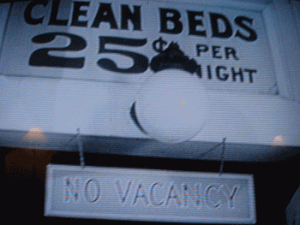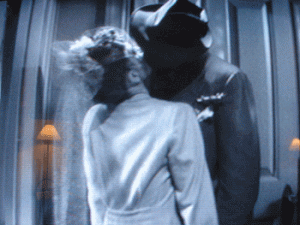 The More The Merrier, 1943. Directed by George Stevens. Written by the crazy quintet of Robert Russell, Frank Ross, Richard Flourny, Louis R. Foster, and an uncredited Garson Kanin. Starring Jean Arthur, Joel McCrea, Charles Coburn, bug-eyed Richard Gaines, and a cast of happy homeless in Washington, D.C.
The More The Merrier, 1943. Directed by George Stevens. Written by the crazy quintet of Robert Russell, Frank Ross, Richard Flourny, Louis R. Foster, and an uncredited Garson Kanin. Starring Jean Arthur, Joel McCrea, Charles Coburn, bug-eyed Richard Gaines, and a cast of happy homeless in Washington, D.C.
There was this moment in time when the world went crazy and everyone took up arms. Germany, Japan, Russia, Britain, America… really, almost literally the whole world decided to try and kill one another and wreck the cities and the countryside. It was terrible. Good men and women here in the United States went off to fight this war or to do the jobs necessary to the effort. No one knew what would happen tomorrow. For all anyone knew, they or their loved ones might be dead in short order.
There was this moment in time when Washington, D.C., was a strange whirlwind of a place, where the great rivers of people flowing toward this war gathered. Before the big fight Washington had been a sleepy town, a government town, and then suddenly there were thousands and thousands of people. Too many people. There weren’t enough rooms in hotels, not enough apartments, and the good citizens were sharing rooms, sharing floor space, trying to fit in where they could.
There was this moment in time when all these lovely men and women were thrown together, men readying to fight, men too old to fight but in town to do government work, and the women who were here to work, too, in many cases for the first time in their lives. But they were young women, girls really, and the men were boys, in town for just a few days before they went off to the great and horrible mystery of war.
The girls actually ended up living in D.C., to work switchboards and such, and so, supposedly, there were eight young women to every one young man. All crowding together. Gas rationing forcing them to share taxis, cars. Too few restaurants meant that the people crammed and crowded the booths and tables, that strangers sat together and ate and talked and talked and talked, because there was much to talk about.
During this moment in time many of these people fell in love. Too often with the “wrong” people. Young women engaged to a man who seemed perfectly reasonable just twenty-two months ago and then suddenly there’s a young Air Force man sharing your apartment and, well… plans change in these troubled times. They always do. And where plans change, stories are made.
You see, there was this moment in time when all these things were happening and someone got the bright idea to write a story about it, and make a movie. The movie is The More The Merrier and it reached out to the apple tree that was Washington, D.C. during the war and it picked the biggest, brightest fruit and took a great big bite. Washington was a madhouse, and in the center of this madhouse are three people, all trying to do their best to stick with their plans. But the war, and love, interfere.
The facts: Benjamin Dingle (the wonderful Charles Coburn, who won an Oscar for his performance) is a well to-do retired millionaire. He’s in the nation’s capital at the behest of a senator in order to help out with the city’s housing problem. Unfortunately for Mr. Dingle, he arrived early: there’s no room at the fancy hotel for another forty-eight hours.
Wandering the streets of D.C., he happens upon an advertisement. “Room for rent.” Using the considerable wiles at his disposal, he manages to drive away the long line of hopefuls and land his room. Problem is, that room is situated in an apartment rented by one Connie Milligan, played by Jean Arthur. Milligan is reluctant to share her flat with a man. He convinces her, in part suggesting that a woman roommate would only steal Connie’s clothes.
Poor Connie! She doesn’t know what she’s got herself into, for Dingle’s only the first monkey wrench that’s being tossed in her well-oiled machine. All Constance wants is to do the right thing, follow an exacting timetable every morning (wake at 7; get milk from stoop at 7:01; coffee made by 7:05 and so on), go to her job doing something utterly essential to the war effort, and wait until her fiance finally marries her. He’s got a good job and they’ll settle down after the war. Of course, he’s only almost twenty years her senior, but he makes nearly $8,000 a year. She’s a sensible girl.
Dingle’s a nosy guy. He’s also a guy who’s got a lot out of life and hates to see youth throwing away their youth. And he admires what’s going on: the world is topsy-turvy and these youngsters are stepping up. So he’s going to step up. As he quotes Farragut, “Damn the torpedoes, full speed ahead!”
Damning the torpedoes, he decides to set Connie up with a good man. The next morning, as he’s stepping out the door on his way to work, there appears a “high type, clean cut young fellow” in the person of Joe Carter (Joel McCrea, never better). Now the wheels are working in Dingle’s head. Why not rent out half of his half of the apartment, and Connie will see this handsome young man, and this handsome young man, on his way to war, will see her and they will fall in love. Of course, things get screwy, the two fall in love, and hijinks ensue.
You see, there was this moment in time when laughter always mingled with tears and everything was just so much more intense, acute, the war making everyone aware of the possibilities and fleeting nature of life. And that’s where The More The Merrier differs from other comedies. It is unlike any movie I have ever seen. Joe Carter is a gruff guy, resistant to joy, readying himself for the hell that is going to greet him in a week’s time, when he’s sent to Africa to fight. For a leading man in a comedy, he’s surprisingly grim. At first meeting, there is a wonderful exchange between Dingle and Carter, but there’s a touch of sadness lurking underneath. Carter’s carrying a propellor, as he works with top secret planes for the army, and when asked what he does he tells the old industrialist Dingle that he works for a baby carriage factory. “The Tokyo Baby Carriage Factory. Plain and fancy baby carriages for carrying babies to Tokyo.”
This is a subtle melancholy, this acknowledgment of sending children off to die. This understanding that war is real and ugly colors the whole film, ever so slightly. For this is a moment in time when everyone in Washington knew exactly what was going on: old men become fast friends with young men, knowing that they ought to have some fun because they might not have much time left on earth. Look in the background of this movie, at the people all trying to grab for those little magical minutes spent with a fellow human. People dancing, taking pictures, reading together. And the women were lonely and men were going farther away than ever before and what they were about to experience would change their lives, and perhaps bring about their end. Some of them fall in love, quickly and deeply. As people are wont to do in moments like these.
Joe Carter louses things up, alters Connie’s plans just as the war altered his. She’s engaged to one Mr. Pendergast (Richard Gaines), but Carter is irresistible, and she cannot halt the magnetism drawing them together. They struggle against this, Connie more than Joe. At last they find themselves walking down the street back to her pad, him groping at her, her gently pushing him away but clearly eager to allow the groping to continue. All along the street, in this beautiful scene, couples are in the shadows on doorstops, behind trees, standing in doorways, huddling in the shelter of love before the storm of war. And when the tug-of-war has reached its climax, Connie grabs Joe to kiss him it is, as David Thomson put it, as if she is “seizing a his face as if it were a jug of water and slaking her thirst.”
The More The Merrier is a movie about living in the moment, at a time when life was full of incredible urgencies. The movie makes you laugh, but while there is nothing in it that should make you cry, tears are guaranteed. When the inevitable conclusion arrives, we do not have any sense of “happier ever after”. For Carter could die in Africa, Connie could fall for someone else, anything can happen after the credits roll. All we know is this moment in time. Just like life.
The writers here seemed to understand what the war was about, both at home and on the front, and director George Stevens was readying himself to hit the front lines in Normandy with his camera in a short time, and it appears as if he knew as well. They observed that during war people laugh harder, cry harder, love harder than ever before and convention, wretched convention, is, and should be, swept away for joy. They knew that the good elderly watched the younger generation with pride and wanted them to have some fun when they were home. That young women were scared of falling in love because they didn’t know if the guy who shared their bed would be alive in two weeks’ time. And the guy was probably just as scared.
You cannot remake The More The Merrier any more than you can remake your favorite day with your favorite person. Five writers scratched out this wonderful story, a director shot the thing, and lively actors rehearsed and performed and this beauty was hatched, somehow, inexplicably capturing these fictional, and yet achingly real, two days with utter perfection.
For there was this moment in time when Joe Carter and Constance Milligan crossed paths and fell in love during the great madness of America in World War II. Here is their moment. Watch it and marvel.

